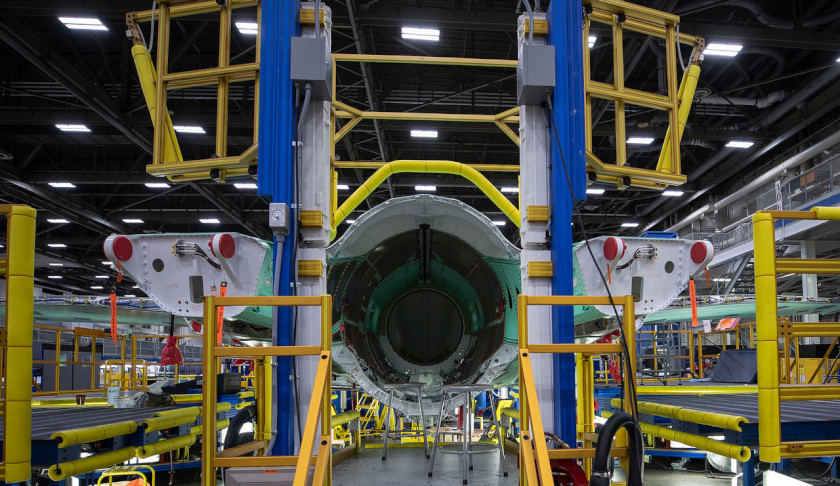Lockheed Martin’s Marietta F-35 team marked a major milestone in the F-35 program, delivering the 500th centre wing (CW) – the milestone CW will be incorporated into CF-55, an F-35C aircraft that will be delivered to the US Navy at NAS Lemoore, California, in 2021.
To continue reading the rest of this article, please log in.
Create free account to get unlimited news articles and more!
The CW is a major structural component and represents nearly one-third of the aircraft’s fuselage.
The aircraft’s wings are attached to the CW during final assembly. Nearly all of the aircraft’s F135 engine case is enclosed in the CWA.
The Marietta team builds CWs for all three F-35 variants, the Conventional Takeoff and Landing (CTOL) F-35A, the Short Takeoff/Vertical Landing (STOVL) F-35B, and the Carrier Variant (CV) F-35C.
Caleb Hendrick, the Marietta F-35 program director said, “What this team has accomplished since assembly began a decade ago and now reaching 500 centre wings delivered is phenomenal.
“The hallmarks of this team have been innovation, flexibility, spirit, and results – all aligned around the expectations of our customers. This team should be proud of the way it works together to support the Warfighters. I want to thank everyone for the job they have done and continue to do.”
Production has ramped up from five CWs delivered in 2011, to 21 in 2012 (the first full-year of production), to 112 CWs in 2019.
The Marietta team is currently scheduled to deliver more than 120 CWs in 2021.
The time span between CW deliveries has dropped from one CW about every 11 manufacturing days in the initial years of the program to one CW every 1.8 manufacturing days in 2020.
In addition to reaching rate production, the team has saved an estimated $80 million from projected costs at the inception of the program to now.
The innovations in the Marietta assembly line were designed to save millions over the life of the F-35 program.
But, in just 500 units, the Marietta team has outpaced even those optimistic estimates that come close to the cost of an entire F-35 aircraft.
A key measurement is hours per unit — the amount of time required to build a CW. The HPU to build CWs for an F-35A CTOL aircraft has improved from roughly 17,000 hours to about 5,000 HPU, beating the original targeted projections significantly.
The Marietta team has also made reductions in HPU for the more complex F-35B STOVL and F-35C CV aircraft at nearly the same rate as for the F-35A CWs.
The HPU for the F-35B CWs has been reduced from approximately 14,000 hours to 5,300 hours. The HPU for the F-35C aircraft has been reduced from roughly 16,000 hours to about 6,000 hours.
Approximately 450 people work directly on the F-35 program in Marietta. In addition to assembling the CWAs on a state-of-the art production line, technicians also apply specialised stealth coatings to the aircraft’s horizontal and vertical tail assemblies.
The tails are shipped to Fort Worth and attached to the aircraft there. The Marietta team also coats spare and repaired doors, panels and covers for the F-35.
The Lockheed Martin F-35 Joint Strike Fighter is billed as a catalyst for the fifth-generation revolution, changing the face and capability of the Royal Australian Air Force and the wider Australian Defence Force.
Ten nations are currently flying F-35s, including the US, UK, Italy, Norway, Israel and Japan. The first of Australia’s F-35A aircraft are now based on home soil after a period of training and development at Luke Air Force Base in Arizona, plus an epic Pacific Ocean crossing in December 2018.
More than 340 F-35s are operating today with partner nations, more than 700 pilots and 6,500 maintainers have been trained, and the F-35 fleet has surpassed more than 170,000 cumulative flight hours.
Over the coming years, Australia will purchase 72 of the advanced fifth-generation fighter aircraft as part of the $17 billion AIR 6000 Phase 2A/B program – which is aimed at replacing the ageing F/A-18A/B Classic Hornets that have been in service with the RAAF since 1985.
Stephen Kuper
Steve has an extensive career across government, defence industry and advocacy, having previously worked for cabinet ministers at both Federal and State levels.

 Login
Login








